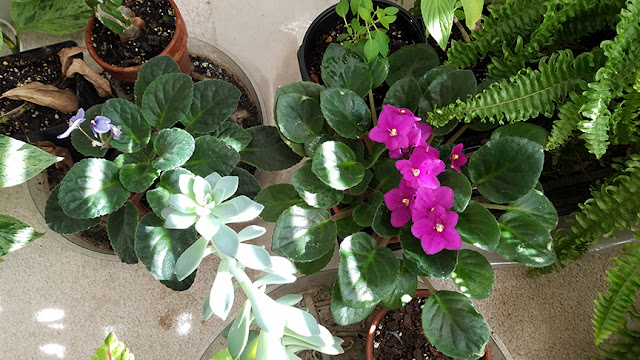 |
Orchids in my bath.
|
For my first post for the Garden Blogger's Bloom Day (a day late) I'm starting with my indoor garden, where I have a couple of orchids in bloom in my bath. The dark pink is a Miltonidia, a hybrid of Miltonia with Oncidium, I believe. This was the first orchid I ever bought many years ago--it was on sale at a local garden center and looked almost dead, but the orchid expert there assured me it would revive if soaked in water for a few hours, which it did. It has bloomed regularly since then.
The other orchid in the bath with fading blooms and a new flowering spike coming up, I bought at a road-side stand during a trip to Florida, and appears to be a Brassia hybrid, maybe Brassidia? It too flowers regularly for me every year during this time. This season it produced three flowering spikes.
 |
Phalaenopsis hybrid
|
Moving along downstairs to the family room is another orchid, a Phalaenopsis hybrid one of my sisters gave me a few years back, that has re-bloomed reliably. I have another five or six florists' orchids around that haven't bloomed in several years, but hope springs eternal in a gardener's heart, so I won't throw them out just yet.
 |
Pink Anthurium
|
Near the Phalaenopsis is this pink Anthurium, also a gift from my sisters. The African violet below is one of two Optimara varieties I've grown for nearly forty years; I've kept them going by taking leaf cuttings regularly.
 |
| Optimara African violet (Saintpaulia hybrids) |
|
|
The plant below is the exotic Gardenia Tree (Tabernaemontana divaricata) which I've been growing for about seven years now, and blooms during winter. The flowers have a marvelous scent for the first six hours after opening, and gradually lose their fragrance. My tree is about three feet high now, and I'm wondering just how much larger it might get--I may have to give it away to someone with a greenhouse when it reaches a size I can't accommodate.
 |
Gardenia tree (Tabernaemontana divaricata)
|
The only thing blooming outdoors in my USDA Zone 6b garden is a native witchhazel tree (Hamamelis virginiana), and some buds are appearing on a Japanese Andromeda (Pieris japonica).
 |
| Witchhazel blossoms. |
|
 |
Japanese Andromeda cultivar in bud.
|
There is one more blossom to account for, but this one is the fruit of my artistic endeavors--a flame azalea watercolor that I finally finished. As I was painting this, it was exciting to I learn that the eastern Tiger Swallowtail butterfly is one of the few insects that can pollinate these native azaleas in the wild.
 |
Flame Azalea and Pollinator.
|
I photographed the flowers and the butterflies two years ago during a trip to a West Virginia forest.


































